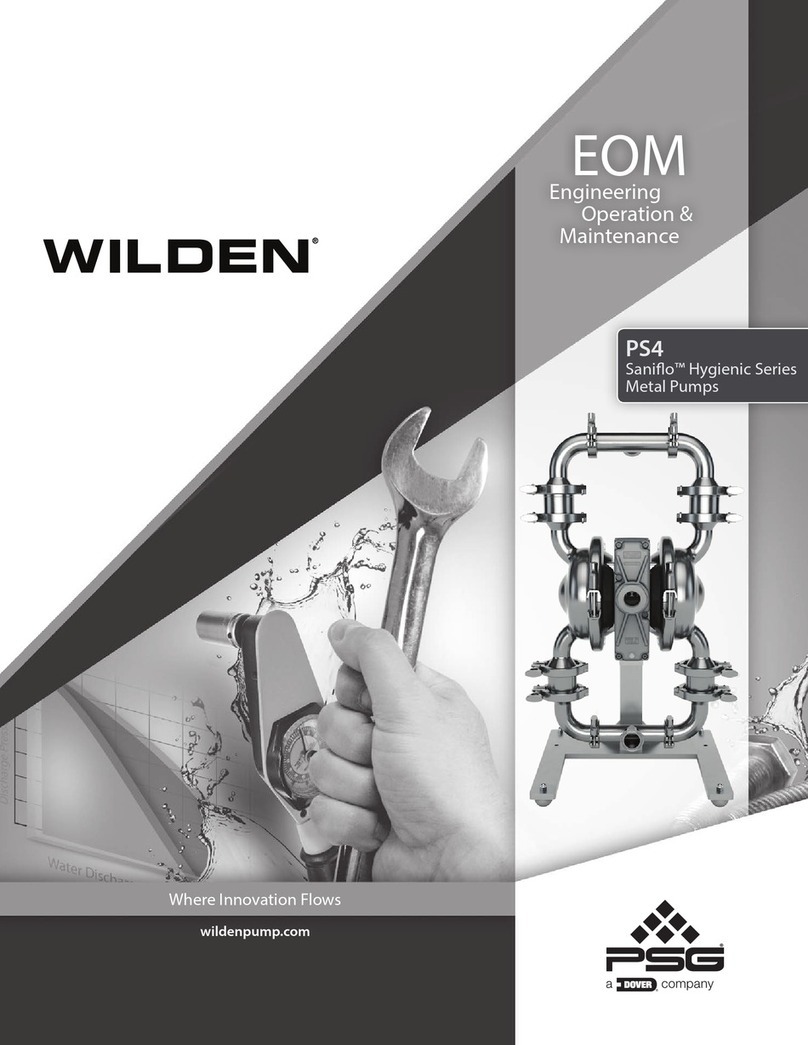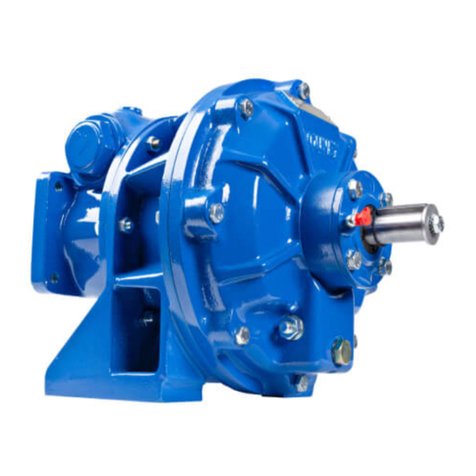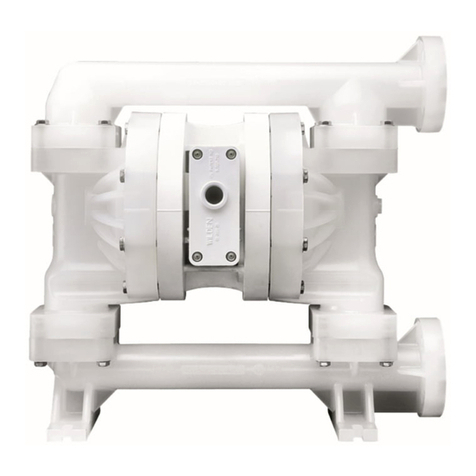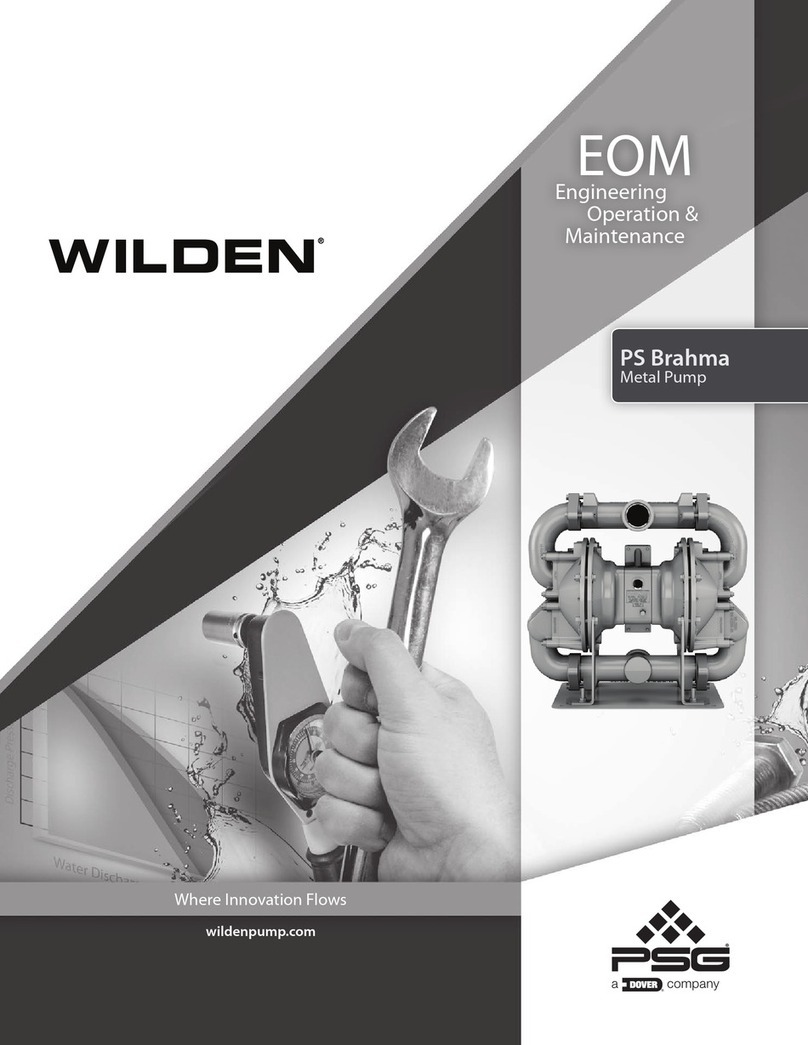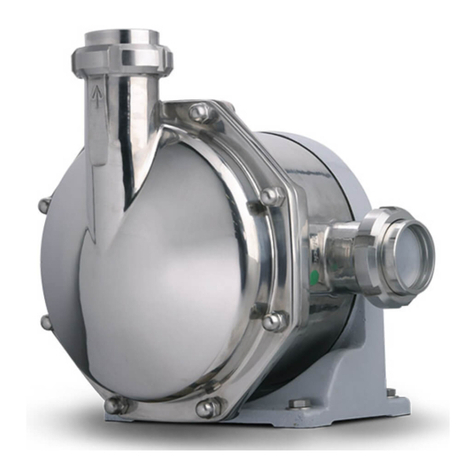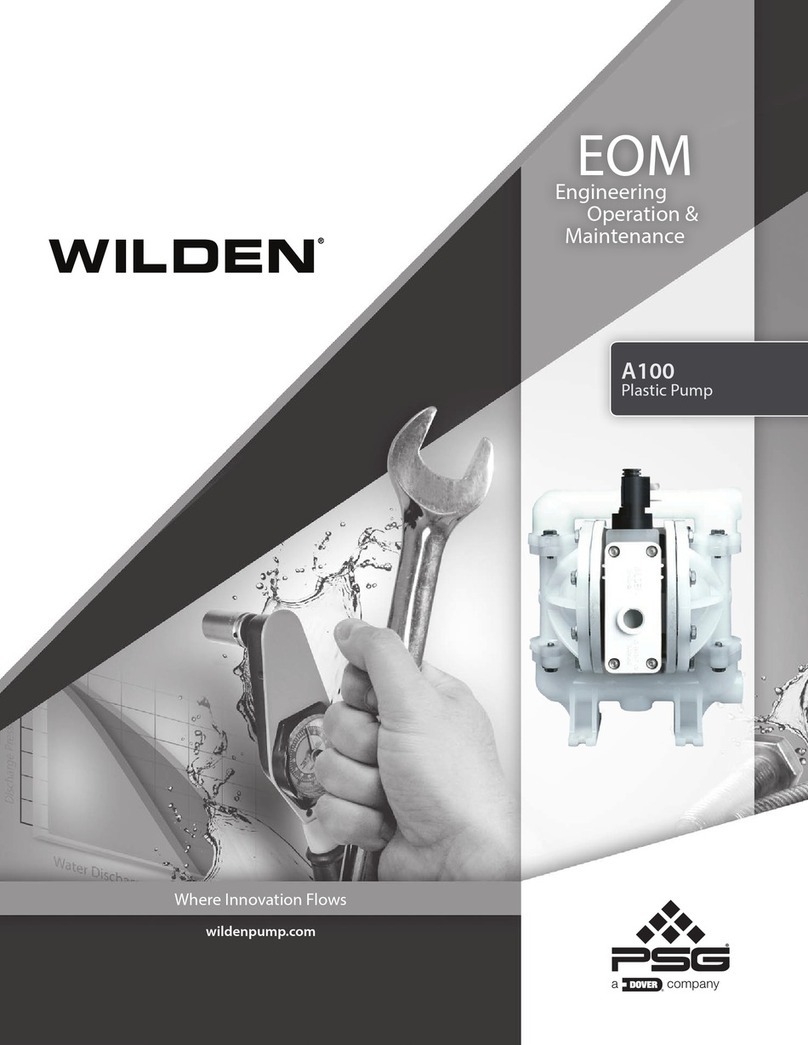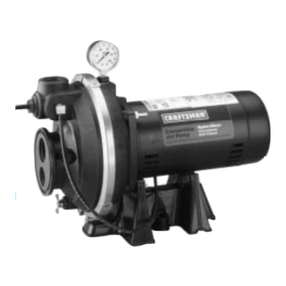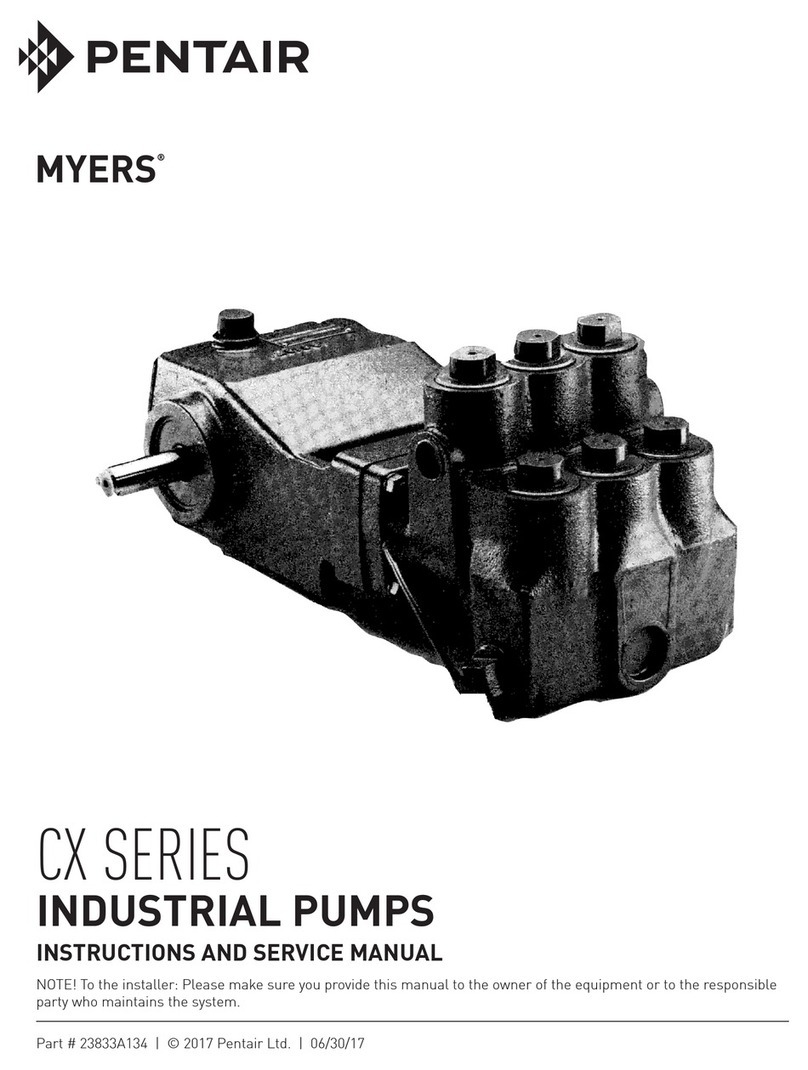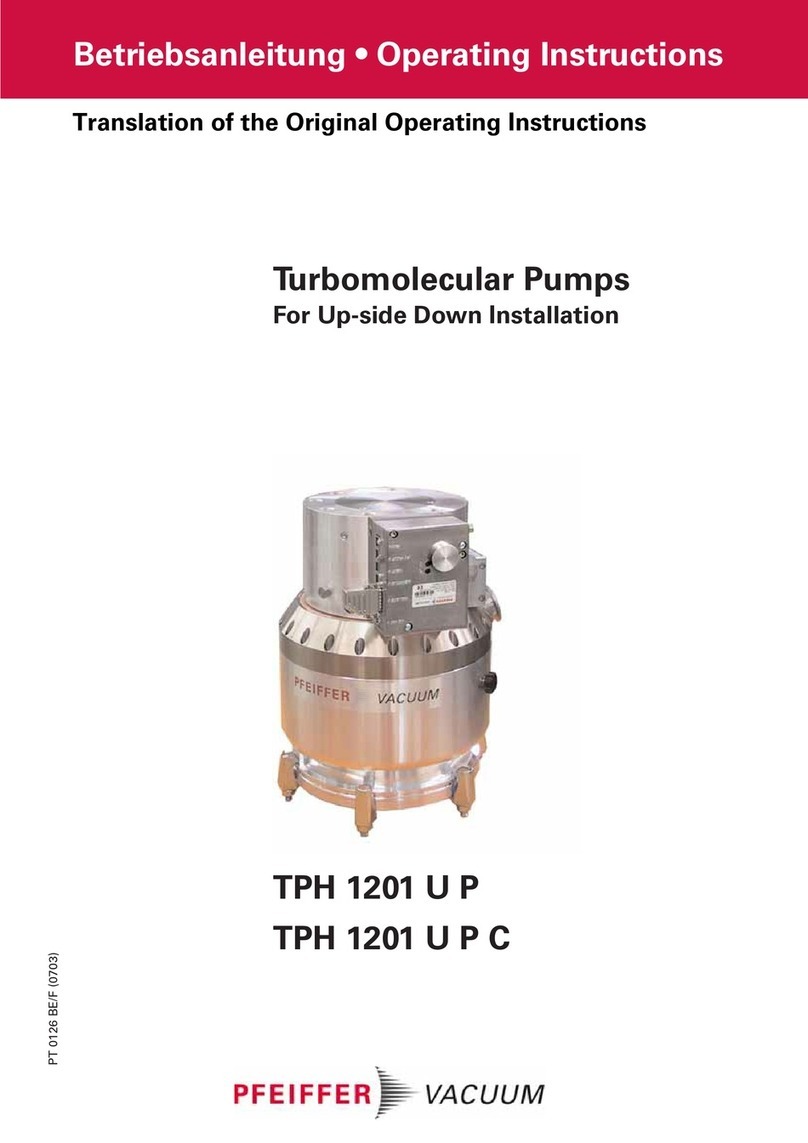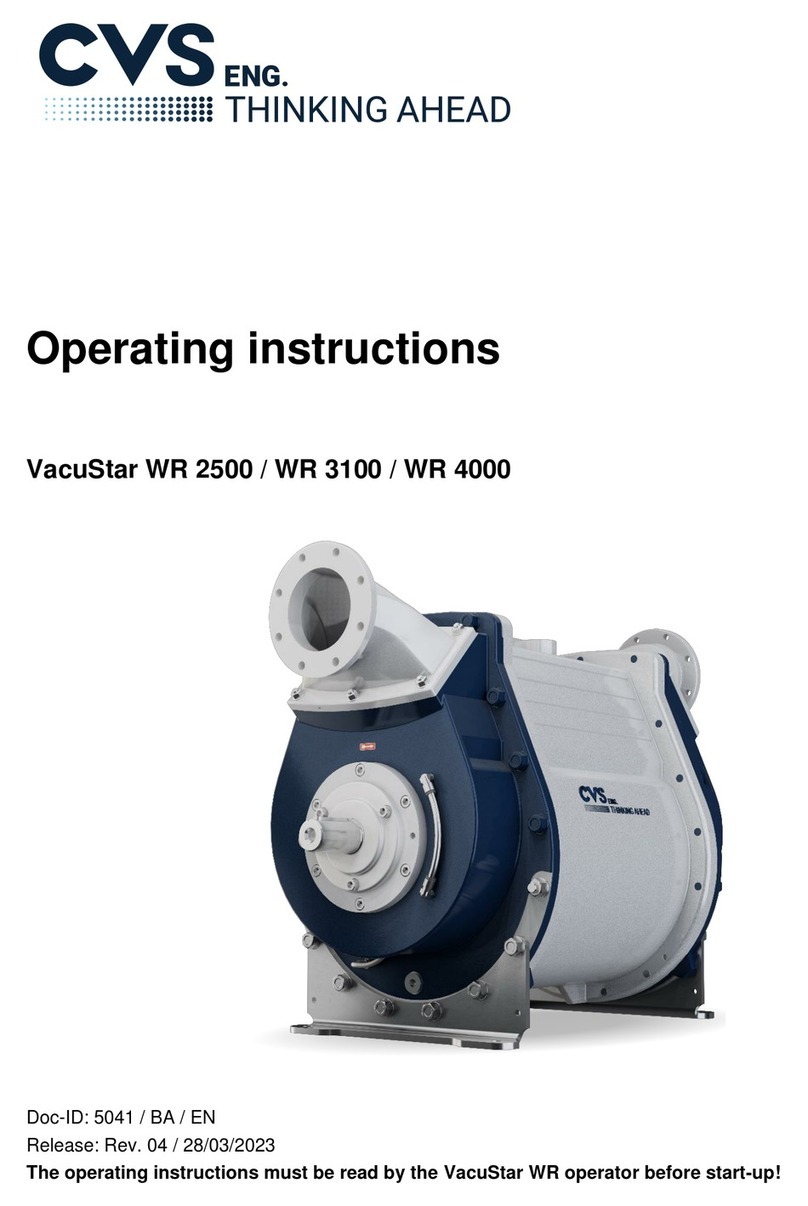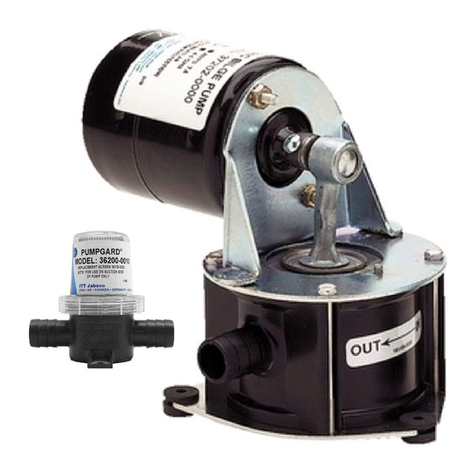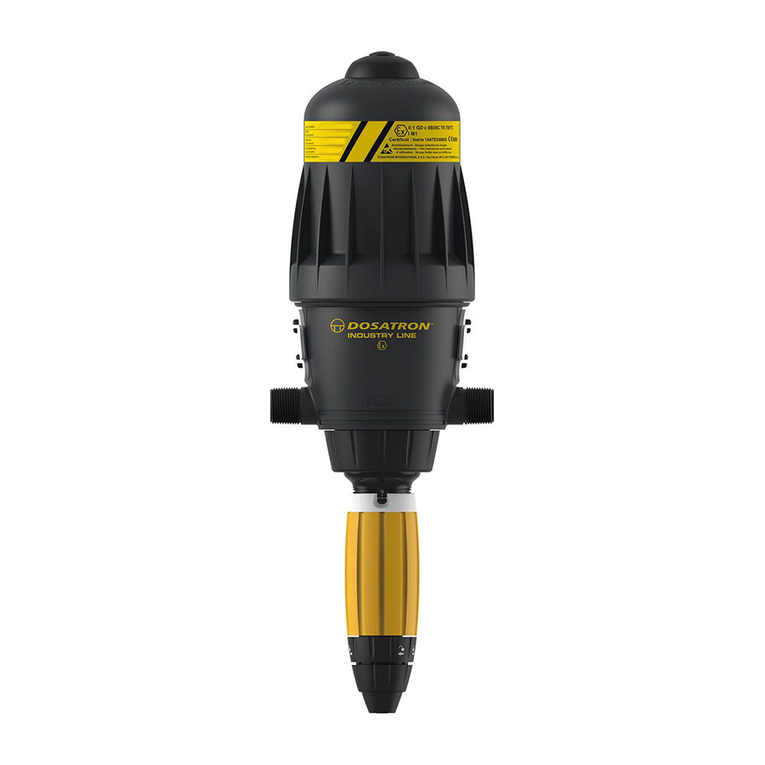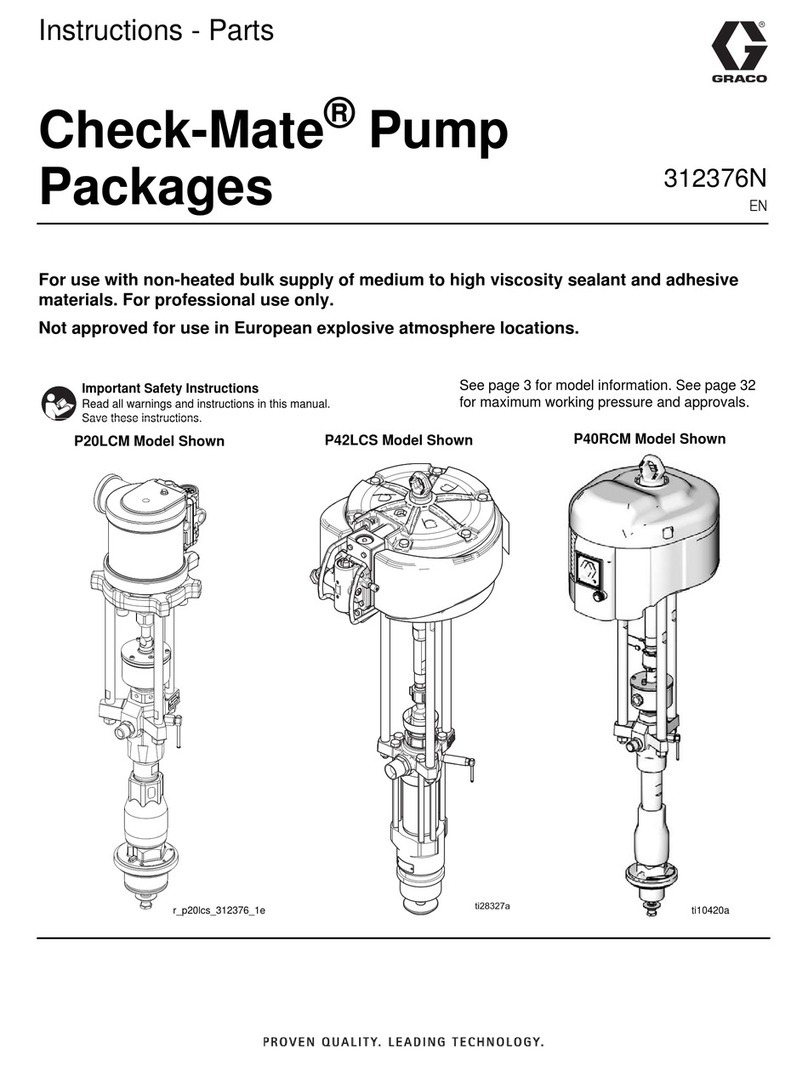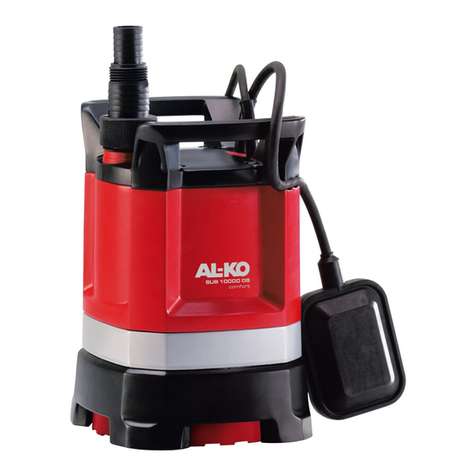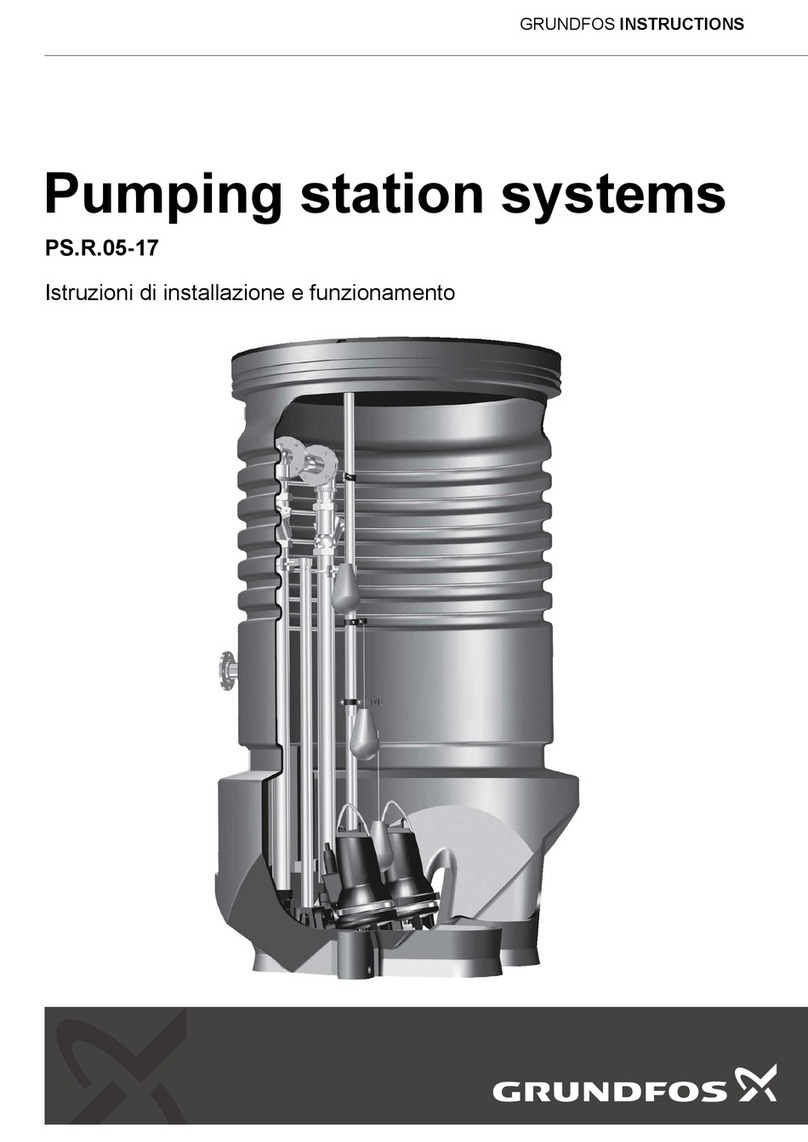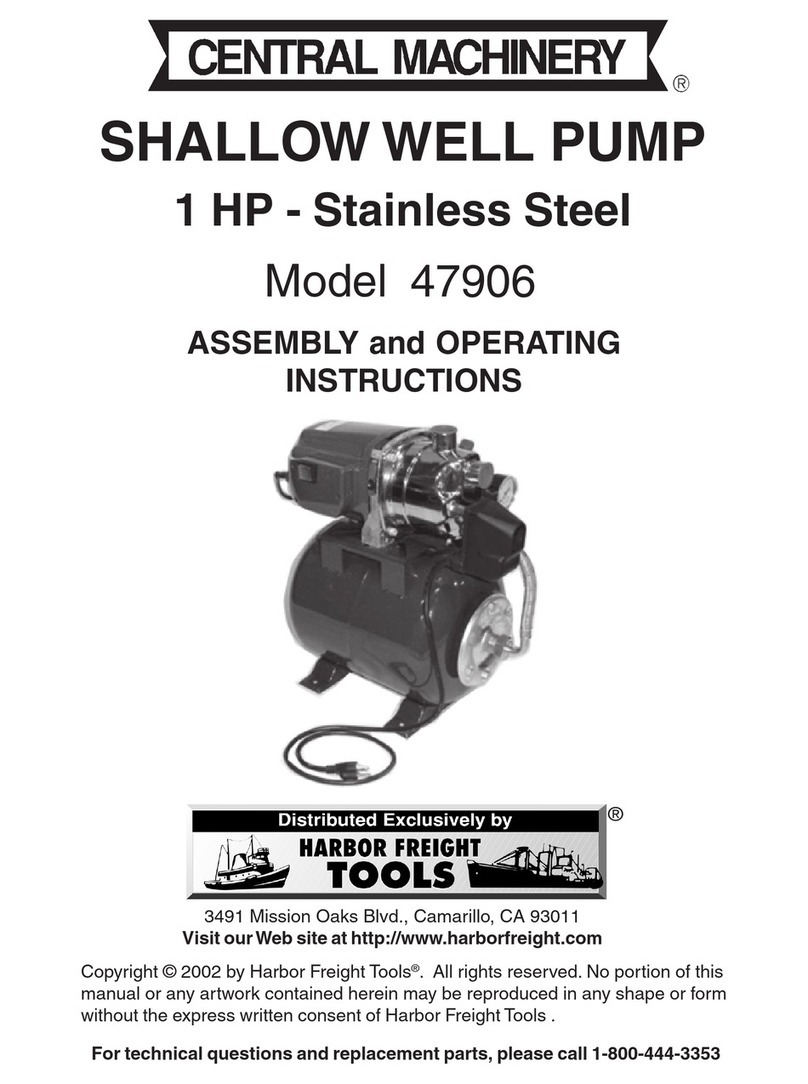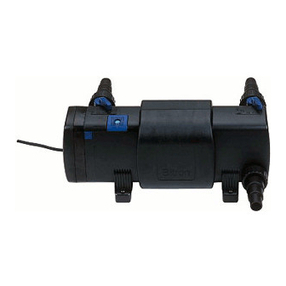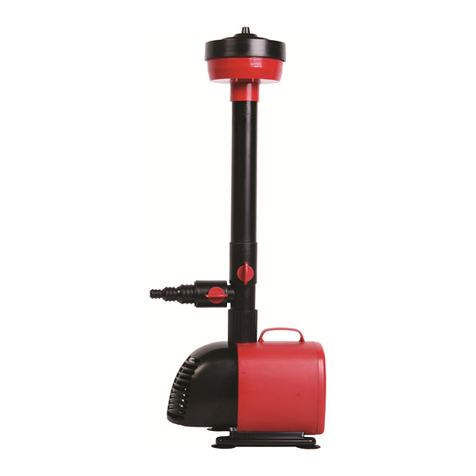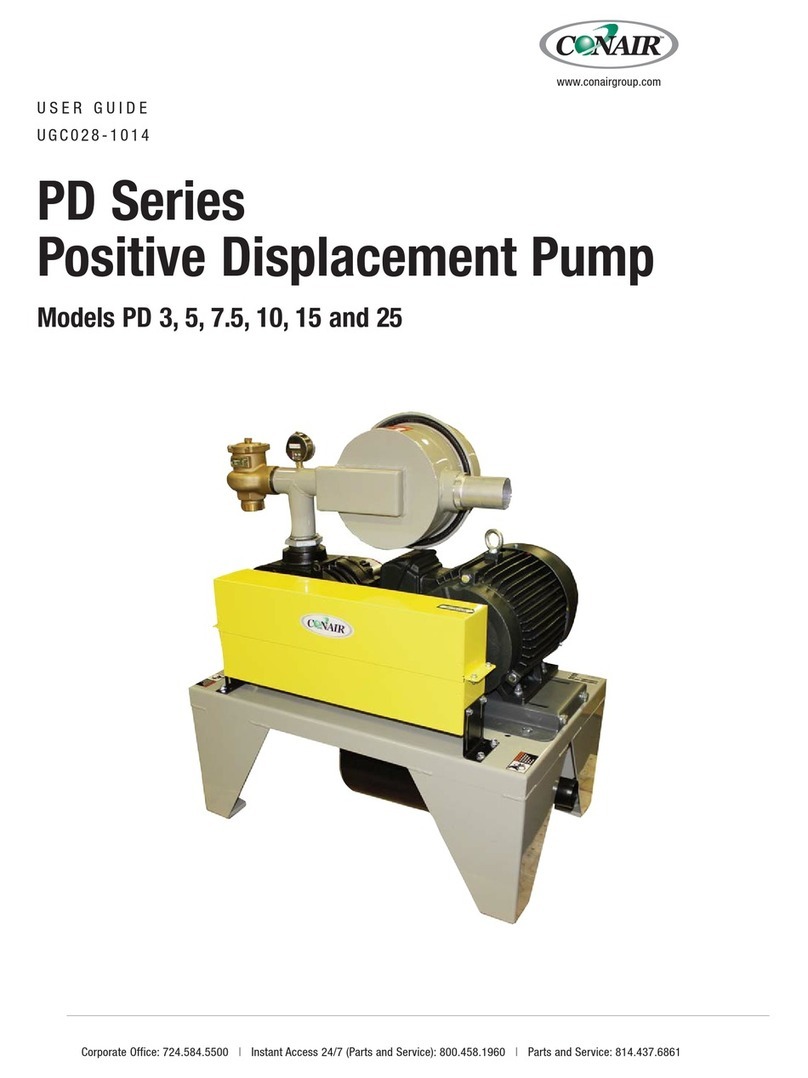
PUMP DESIGNATION SYSTEM
CAUTIONS & WARNINGSBASIC TROUBLESHOOTINGSUGGESTED INSTALLATION
VELOCITY PLASTIC PUMP
PUMPTEMPERATURELIMITS:
PVDF and Polypropylene 4°C – 79°C (40°F - 175°F)
CAUTION: Maximum temperature limits are based upon mechanical
stress only. Certain chemicals will significantly reduce maximum
safe operating temperatures. Consult Chemical Resistance Guide for
chemical compatibility and temperature limits.
CAUTION: Do not exceed 6.9 bar (100 psig) air supply pressure.
CAUTION: Verify the chemical compatibility of the process and
cleaning fluid to the pump’s component materials in the Chemical
Resistance Guide.
CAUTION: Plastic series pumps are made from plastic that is not UV
stabilized. Direct sunlight exposure for prolonged periods can cause
deterioration of plastic.
CAUTION: V150 pumps are not submersible.
CAUTION: Always wear safety glasses when operating pump. If
diaphragm rupture occurs, fluid being pumped may be forced out
air exhaust
CAUTION: Before any maintenance or repair is attempted, the
compressed air line to the pump should be disconnected and all air
pressure allowed to bleed from the pump.
CAUTION: Ensure that the air supply line is clear of debris. Use of a
5μ (micron) in-line air filter is recommended.
LEGEND
V150 / XXX X X / XXX/XX/XXX/XXXX
O-RINGS
VALVE SEAT
MODEL
VALVE BALLS
DIAPHRAGMS
WETTED PARTS &
OUTER PISTON
AIR VALVE
CENTER SECTION
SPECIALTY
CODE
(if applicable)
V150 TPE-FITTED PERFORMANCE CURVE V150 PTFE-FITTED PERFORMANCE CURVE
V150 DRY SUCTION-LIFT CURVE
A150V 70/30 OPERATING CONDITIONA150V PERFORMANCE CURVE
Engineering
Operation &
Maintenance
Pump will not run or runs slowly:
1. Ensure the air inlet pressure is 0.3 bar (5 psig) above the start-up pressure of
the pump.
2. Ensure the differential pressure (difference between the air inlet pressure and
fluid discharge pressure) is not less than 0.7 bar (10 psig).
3. Check air line/filter for blockage/debris. Check for obstruction in the air
passageways of the pump.
4. Check for objects in the pump that would obstruct the movement of internal parts.
5. Check for severe air leakage (blow-by) coming from the air exhaust. This could
indicate a failed O-ring seal or worn air valve assembly.
6. Inspect for check valve failure. A worn check ball can get stuck in the seat. A check
ball can swell and become stuck if not compatible with fluid pumped. Replace if
necessary.
Pump runs but little or no product flows:
1. Check for cavitation. Confirm vacuum required to lift the fluid is not greater than
the vapor pressure of the fluid being pumped. Slow pump speed to allow viscous
fluids to flow into liquid chambers.
2. Ensure that the suction lift requirement is within the pump model’s capability.
3. Inspect for check valve failure. A worn check ball can get stuck in the seat. A check
ball can swell and become stuck if not compatible with fluid pumped. Replace if
necessary.
Air bubbles in pump discharge:
1. Check for ruptured diaphragm.
2. Check tightness of outer piston to shaft.
3. Check integrity of O-ring seals, especially intake side of manifold.
4. Ensure pipe connections are airtight.
Product comes out of air exhaust:
1. Check for ruptured diaphragm.
2. Check tightness of outer piston to shaft.
PUMP SELECTION: Ensure that pump materials of construction are compatible with the
pumping media and the immediate surroundings the pump will be subjected to. Refer to the
Wilden Chemical Resistance Guide. For optimum life and performance, the pump size should be
specified so that daily operation parameters are not near the pump’s maximum rated performance
capabilities.
INSTALLATION: The pump has two foot mount configurations and can be mounted in any
orientation. The pump can be mounted in place or left free standing for use in multiple locations.
If the pump is to be mounted in place, it is suggested to attach the foot to the desired surface
using 4 screws (not supplied) and then attach the pump to the foot using the 4 supplied #12 screws.
PIPING: The suction and discharge piping diameter should be equivalent or larger than the
diameter of pump connection, the length and complexity of the suction and discharge piping
should be minimized, unnecessary elbows, bends and fittings should be avoided, all in an effort
to reduce friction losses.
The suction hose must be non-collapsible. If rigid piping is used, it should be supported
independently of the pump. In addition, the piping should be aligned to avoid placing stress on
the pump fittings.
When used in self-priming applications, it is critical that all fittings and connections are airtight or
a reduction or loss of pump suction capability will result. Ensure that the suction lift requirement
is within the pump model’s capability.
AIR SUPPLY: Every pump should have an airline large enough to supply the volume of air
necessary to achieve the desired pumping rate. Air pressure to the pump should not exceed a
maximum of 6.9 bar (100 psig). For best results, the pumps should use a 5μ (micron) air filter to
eliminate air-line contaminants, a needle valve and pressure regulator.
SOLENOID CONTROL: When start-stop operation of a standard air valve equipped pump is
controlled by a solenoid valve in the air line, a three-way (3/2) solenoid valve should be used to
vent pressurized air between the solenoid and pump when the pump is stopped.
REMOTE SOLENOID OPERATION: When the remote solenoid option is being used, a five-
way (5/2) solenoid valve must be used to control the operation of the pump. Minimize the length of
tubing between the solenoid and the two pump inlets to improve pump performance.
PUMP OPERATION: Tighten all hardware to suggested torque specifications prior to initial
start-up. Once installation is complete, pump operation can be started by opening the air shut-off
valve (do not exceed the pump’s maximum rated pressure). The pressure regulator and needle
valve are used to adjust the speed of the pump.
Ship Weight ..........PVDF 3.7 kg (10 lb)
Polypropylene 3 kg (8 lb)
Air Inlet .......................... 13 mm (1/2”)
Inlet ................................ 13 mm (1/2”)
Outlet ............................. 13 mm (1/2”)
Suction Lift ...............5.1 m Dry (16.9’)
7.9 m Wet (26’)
Disp. per Stroke1....... 0.11 L (0.03 gal)
Max. Flow Rate ........64 lpm (17 gpm)
Max. Size Solids..........1.6 mm (1/16”)
1Displacement per stroke was
calculated at 4.8 bar (70 psig) air inlet
pressure against a 2.1 bar (30 psig)
head pressure.
Example: To pump 5.7 lpm (11.5 gpm)
against a discharge head of 2.8 bar
(40 psig) requires 5.5 bar (80 psig) and
23.8 Nm3/h (14 scfm) air consumption.
Caution: Do not exceed 6.9 bar (100
psig)air supplypressure.
Suction lift curves are created using pumps operating at 305 m (1000’) above sea level. This chart is meant to
be a guide only. There are many variables which can affect the pump’s operating characteristics. Suction lift
can be affected by the number of intake/discharge elbow, viscosity of pumping fluid, elevation (atmospheric
pressure), pipe friction losses and other factors.
Caution: Do not exceed 6.9 bar (100 psig) air supply pressure.
Flow rates indicated on chart were determined by pumping water.
For optimum life and performance, pumps should be specified so that daily operation
parameters will fall in the center of the pump’s performance curve.
Flow rates indicated on chart were determined by pumping water.
For optimum life and performance, pumps should be specified so that daily operation
parameters will fall in the center of the pump’s performance curve.
Flow rates indicated on chart were determined by pumping water.
For optimum life and performance, pumps should be specified so that daily operation
parameters will fall in the center of the pump’s performance curve.
DIAPHRAGMS
TSS = FULL-STROKE PTFE W/ SANIFLEX
BACK-UP O-RING
ZWS = WIL-FLEX™ [Santoprene®
(Three Black Dots)]
VALVE BALLS
TF = PTFE (White)
WF = WIL-FLEX™ [Santoprene®
(Three Black Dots)]
VALVE SEAT
K = KYNAR
P = POLYPROPYLENE
VALVE SEAT O-RING
TV = PTFE-ENCAP. FKM
WF = WIL-FLEX (Santoprene®)
SPECIALTY CODES
0150 Accu-Flo, 24V DC Coil
0151 Accu-Flo, 24V AC/12V Coil
0155 Accu-Flo, 110V AC Coil
MODEL
V150 = 13 mm (1/2”) VELOCITY
A150V = 13 mm (1/2”) ACCU-FLO™
WETTED PARTS & OUTER PISTON
KK = PVDF / PVDF
PP = POLYPROPYLENE / POLYPROPYLENE
AIR CHAMBER / CENTER BLOCK
PP = POLYPROPYLENE
AIR VALVE
A = ALUMINUM (ACCU-FLO Only)
E = PET
MATERIAL CODES
This curve demonstrates the flow created when the stroke rate is varied under static air and fluid pressure conditions.
This curve can be applied to different pressure conditions to estimate the change in flow due to stroke rate.
Ship Weight ..........PVDF 3.7 kg (10 lb)
Polypropylene 3 kg (8 lb)
Air Inlet .......................... 13 mm (1/2”)
Inlet ................................ 13 mm (1/2”)
Outlet ............................. 13 mm (1/2”)
Suction Lift ...............5.1 m Dry (16.9’)
7.9 m Wet (26’)
Disp. per Stroke1....... 0.11 L (0.03 gal)
Max. Flow Rate .....39 lpm (10.5 gpm)
Max. Size Solids..........1.6 mm (1/16”)
1Displacement per stroke was
calculated at 4.8 bar (70 psig) air inlet
pressure against a 2.1 bar (30 psig)
head pressure.
Example: To pump 18.9 lpm (5 gpm)
against a discharge head of 2.1 bar (30
psig) requires 4.1 bar (60 psig) and 8.4
Nm3/h (5 scfm) air consumption.
Caution: Do not exceed 6.9 bar (100
psig)air supplypressure.
Ship Weight ..........PVDF 3.7 kg (10 lb)
Polypropylene 3 kg (8 lb)
Air Inlet .......................... 13 mm (1/2”)
Inlet ................................ 13 mm (1/2”)
Outlet ............................. 13 mm (1/2”)
Suction Lift ..................4.8 m Dry (16’)
7.9 m Wet (26’)
Disp. per Stroke1....... 0.11 L (0.03 gal)
Max. Flow Rate ........64 lpm (17 gpm)
Max. Size Solids..........1.6 mm (1/16”)
1Displacement per stroke was
calculated at 4.8 bar (70 psig) air inlet
pressure against a 2.1 bar (30 psig)
head pressure.
Example: To pump 34 lpm (5.9 gpm)
against a discharge head of 4.8 bar
(70 psig) requires 5.5 bar (80 psig) and
15.3 Nm3/h (9 scfm) air consumption.
Caution: Do not exceed 6.9 bar (100
psig)air supplypressure.
WIL-41010-E-01 WIL-41010-E-01
WIL-41010-E-01WIL-41010-E-01WIL-41010-E-01
WIL-41010-E-01
WIL-41010-E-01WIL-41010-E-01













